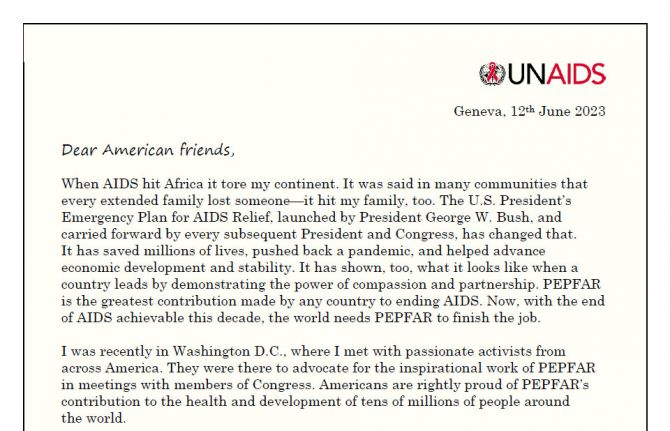
Feature Story
Ten years since PEPFAR’s launch: The United States continues its leadership in the AIDS response
14 February 2013
14 February 2013 14 February 2013Exactly ten years ago, President George W. Bush announced the creation of The Presidents Emergency Plan for AIDS Relief (PEPFAR) in his State of the Union Address. When it was created, back in 2003, PEPFAR’s initial aim was to provide antiretroviral treatment to 2 million people living with HIV in resource-limited settings, to prevent 7 million new HIV infections, and to provide care and support to 10 million people by 2010.
Since those early days PEPFAR has come a long way, far exceeding its initial goals. By 2012 PEPFAR was directly supporting life-saving antiretroviral treatment for more than 5 million men, women and children worldwide. In 2012 alone PEPFAR supported HIV testing and counselling for more than 11 million pregnant women and provided medicines to prevent new HIV infections in children to around 750 000 women who tested positive for HIV. According to PEPFAR, this allowed 230 000 children to be born free from HIV.
“The leadership of the United States of America in the AIDS response has been instrumental in achieving results for people living with and affected by HIV,” said UNAIDS Executive Director Michel Sidibé. “Over the last 10 years new HIV infections worldwide have fallen by more than 20%, and as more people have been able to access antiretroviral therapy, AIDS-related deaths have fallen by a staggering 25% since the peak of the epidemic. These gains would not have been possible without the financial and political commitment of the United States and particularly PEPFAR,” he added.
The United States’ continuing leadership in the AIDS response was further confirmed this week when President Barack Obama gave his annual State of the Union Address. In the hour-long address, President Obama directly talked about the United States’ commitment to achieving an AIDS-free generation.
The leadership of the United States of America in the AIDS response has been instrumental in achieving results for people living with and affected by HIV
UNAIDS Executive Director Michel Sidibé
“In many places, people live on little more than a dollar a day. So the United States will join with our allies to eradicate such extreme poverty in the next two decades: by connecting more people to the global economy and empowering women; by giving our young and brightest minds new opportunities to serve and helping communities to feed, power, and educate themselves; by saving the world’s children from preventable deaths; and by realizing the promise of an AIDS-free generation.”
In July 2012, Secretary Hilary Rodham Clinton called on PEPFAR to produce a blueprint outlining how the United States will contribute to reaching an AIDS-free Generation which was subsequently launched in December of that year.
The Blueprint: Creating an AIDS-free Generation, reflects on lessons learned from PEPFAR’s experience in supporting countries to rapidly scale-up HIV prevention, treatment and care services. It also highlights the unprecedented opportunity the world has to help move more countries towards and beyond the tipping point in their epidemics and put them on a path to achieving an AIDS-free generation.
The blueprint makes clear that the United States’ commitment to this goal will remain strong, comprehensive and driven by science and will serve as a roadmap for the United States’ response to HIV in the coming years.



